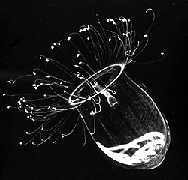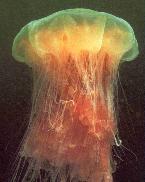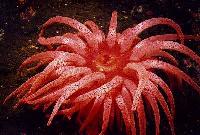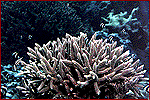Cnidaria
Reminder: Clicking on the picture will take you to the site where I originally found it.
Leave it to the Greeks to invent a word with a silent letter"C" in it. The Greek work cnidos means stinging nettle. The cnidarians (pronounced ny-DARE-ee-uns) are animals with stinging cells. This phylum is also known as coelenterata, or colenterates.
Generally speaking, there are two main shapes which cnidarians may take. These shapes are the medusa and the polyp. A jellyfish is a medusa shape. The shape is like an umbrella. The tentacles hang down around the edge of the umbrella, and the mouth would be where the handle attaches. By flexing and relaxing its body, the medusa-shaped cnidarian can move through the water.
The other shape a cnidarian may take is the polyp. Imagine this umbrella placed upside-down so that it forms a dish. The handle attachment, which corresponds to where the mouth is located, is now on top. This is the form of the sessile, or non-moving cnidarians.
 What animals qualify as cnidarians? To start with, there are the jellyfish. As before mentioned, jellyfish are in the mobile, medusa form. They are capable of movement through the water. Jellyfish range in size from the very small to very large.
What animals qualify as cnidarians? To start with, there are the jellyfish. As before mentioned, jellyfish are in the mobile, medusa form. They are capable of movement through the water. Jellyfish range in size from the very small to very large.
Some jellyfish are capable of living in freshwater but the majority live in the oceans. Jellyfish begin their lives as fertilized eggs. The eggs hatch into larvae, which resemble the one-celled protozoans. These larvae settle down and grow a stalk, or a polyp. The polyp is able to reproduce asexually, budding out new jellyfish. This creates the adult, free-living jellyfish we know.
 Like all cnidarians, jellyfish are capable of stinging. When an animal brushes across the tentacles, stinging cells release a dart. The tentacles encoil the animal, drawing it into the jellyfish mouth. Unused wastes are expelled through the same orifice.
Like all cnidarians, jellyfish are capable of stinging. When an animal brushes across the tentacles, stinging cells release a dart. The tentacles encoil the animal, drawing it into the jellyfish mouth. Unused wastes are expelled through the same orifice.
Jellyfish can sting humans as well. It's not the jellyfishes fault. They sting anything which brushes the tentacles, even if they have no intention of eating the critter. Some jellyfish are quite poisonous, and if they're located in the water, swimmers are advised not to go there. Some jellyfish can kill a person in about 20 minutes. Other jellyfish are only irritants. Scientists are working on lotions to prevent jellyfish stings for ocean swimmers.
 A typical sessile (non-moving) cnidarian is the sea anemone. An anemone is a flower, and the animal called the sea anemone certainly looks like a flower. It is often brightly colored and doesn't move around. Like the jellyfish, it has stinging cells and tentacles to obtain its prey.
A typical sessile (non-moving) cnidarian is the sea anemone. An anemone is a flower, and the animal called the sea anemone certainly looks like a flower. It is often brightly colored and doesn't move around. Like the jellyfish, it has stinging cells and tentacles to obtain its prey.
In my opinion, sea anemones are one of the most beautiful groups of invertebrates. They are also pretty practical. They can reproduce sexually or asexually. Their appearance as sea-flowers brings fish close enough to become dinner.
Although they don't move much, anemones can move. They slide around on their basal discs, or their bases. Most movement is too slow to be seen directly. Before they hit maturity and settle down as polyps, their larvae can swim freely.
 Another important cnidarian is the coral. When we picture coral, we're usually picturing the calcium skeletons these cells secrete. The real coral is the living cells which live in the skeletons. Most are colored more brilliantly than their skeletons.
Another important cnidarian is the coral. When we picture coral, we're usually picturing the calcium skeletons these cells secrete. The real coral is the living cells which live in the skeletons. Most are colored more brilliantly than their skeletons.
Corals filter their food out of the surrounding water. They have stinging cells, like their relatives, and can trap small prey. Corals are also a benefit for other creatures because they build reefs. Coral reefs are the most productive places in the oceans.
Scientists are worried because the coral reefs have been dying. This is a very bad sign in earth's oceans. Water temperatures, pollutions, human contact and other factors may be causing coral die-off.
By the way, check out the coral cam.
All the way back to the animal page,
see sponges,
meet the mollusks,
advance to the arthropods,
enquire about the echinoderms,
wade through the worms,
commune with the chordates or
over to the overview.
 What animals qualify as cnidarians? To start with, there are the jellyfish. As before mentioned, jellyfish are in the mobile, medusa form. They are capable of movement through the water. Jellyfish range in size from the very small to very large.
What animals qualify as cnidarians? To start with, there are the jellyfish. As before mentioned, jellyfish are in the mobile, medusa form. They are capable of movement through the water. Jellyfish range in size from the very small to very large.  Like all cnidarians, jellyfish are capable of stinging. When an animal brushes across the tentacles, stinging cells release a dart. The tentacles encoil the animal, drawing it into the jellyfish mouth. Unused wastes are expelled through the same orifice.
Like all cnidarians, jellyfish are capable of stinging. When an animal brushes across the tentacles, stinging cells release a dart. The tentacles encoil the animal, drawing it into the jellyfish mouth. Unused wastes are expelled through the same orifice. A typical sessile (non-moving) cnidarian is the sea anemone. An anemone is a flower, and the animal called the sea anemone certainly looks like a flower. It is often brightly colored and doesn't move around. Like the jellyfish, it has stinging cells and tentacles to obtain its prey.
A typical sessile (non-moving) cnidarian is the sea anemone. An anemone is a flower, and the animal called the sea anemone certainly looks like a flower. It is often brightly colored and doesn't move around. Like the jellyfish, it has stinging cells and tentacles to obtain its prey. Another important cnidarian is the coral. When we picture coral, we're usually picturing the calcium skeletons these cells secrete. The real coral is the living cells which live in the skeletons. Most are colored more brilliantly than their skeletons.
Another important cnidarian is the coral. When we picture coral, we're usually picturing the calcium skeletons these cells secrete. The real coral is the living cells which live in the skeletons. Most are colored more brilliantly than their skeletons.